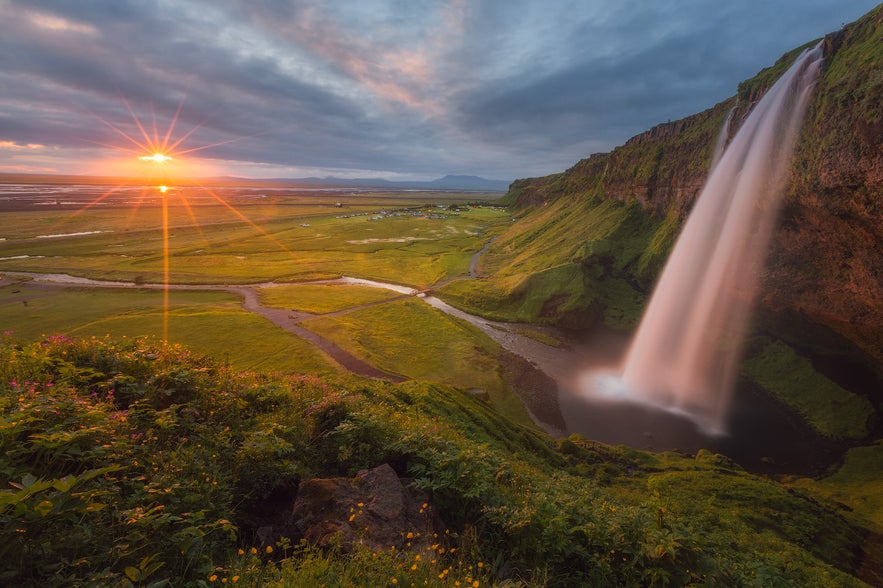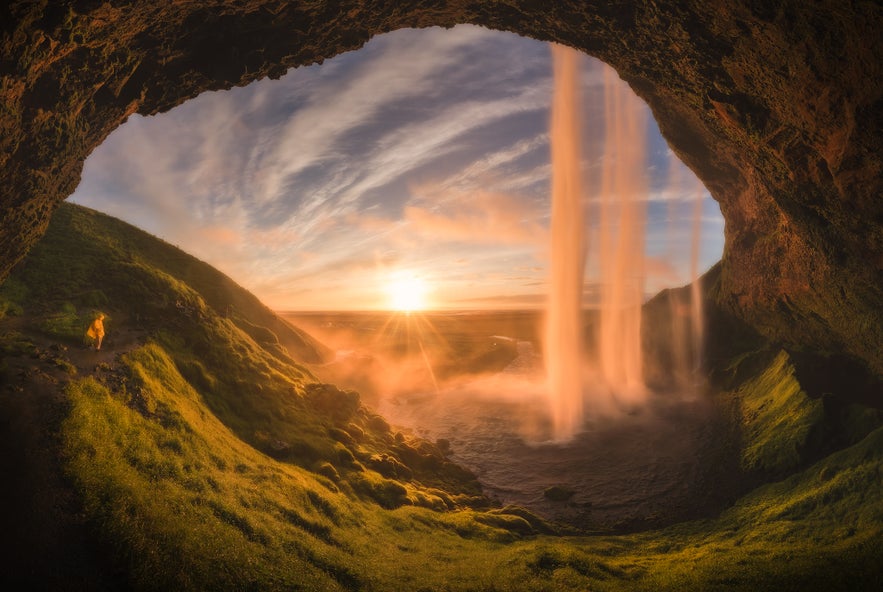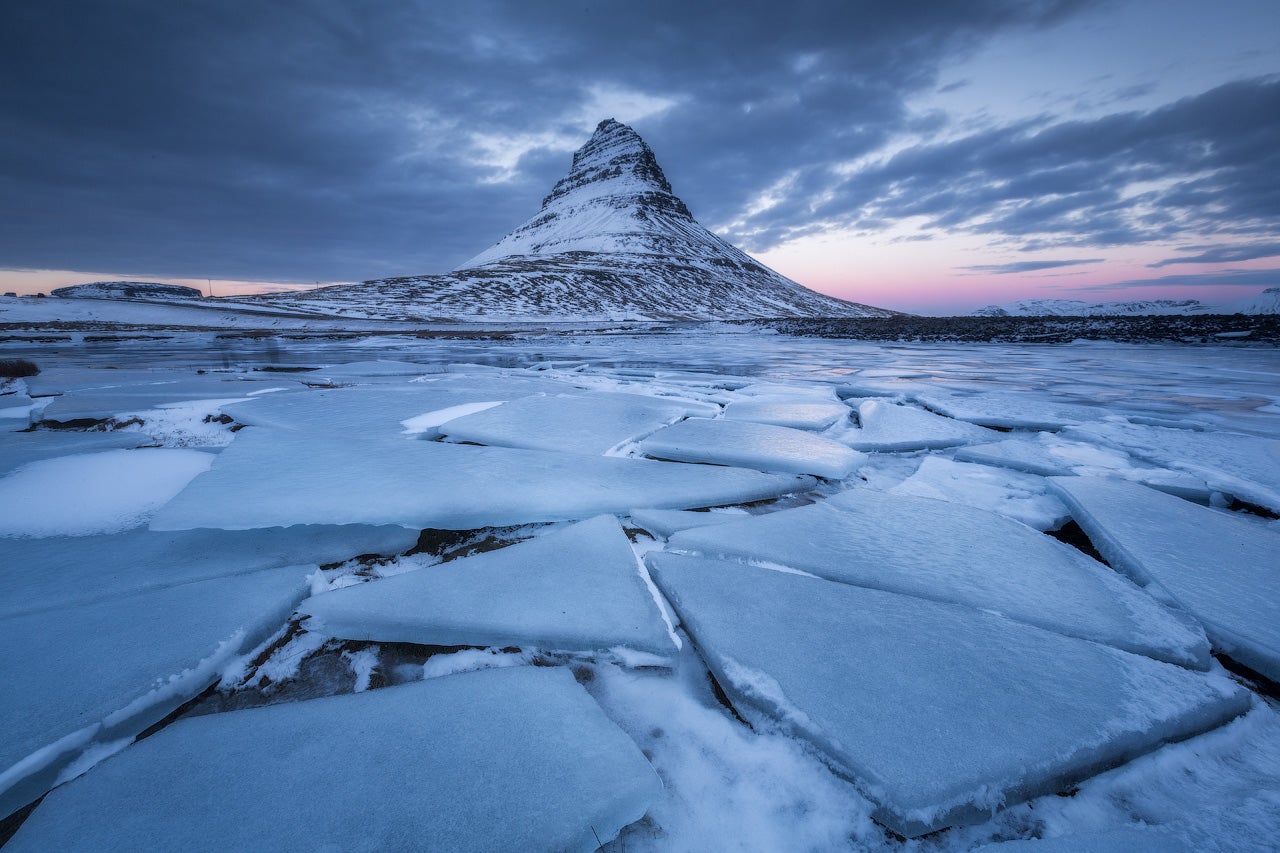
Seljalandsfoss is one of the most famous waterfalls in Iceland and a location that is on nearly every landscape photographer’s bucket list of places to visit. Situated on the south coast of Iceland, it makes for a perfect day tour from Reykjavík that is sure to yield a variety of beautiful images.
- Check out these articles on Photography Techniques
- See these 11 Tips to Help You Capture Stunning Landscape Photographs
- Discover these Photography Workshops
Having said that, it can be a bit of a tricky place to photograph. In this travel photography guide, we’ll explain everything that you need to know about how to get from Reykjavík to Seljalandsfoss in southwest Iceland, what to wear, how long it takes to hike behind the waterfall and what camera settings to use so that you’ll have a great time capturing some stunning pictures.
Facts About Seljalandsfoss
Seljalandsfoss, pronounced phonetically as “sel-ya-lands-foss”, is located on the farmstead of Seljaland between the towns of Selfoss and Vík on the south coast of Iceland. It sits within the spectacular landscape of the Katla UNESCO Geopark, just a short drive from the mighty Skógafoss waterfall, and is one of the most interesting waterfalls in Iceland for photographers.
Seljalandsfoss waterfall has its origins deep within an ice cap that covers the caldera of the famous Eyjafjallajökull volcano – the same volcano that erupted during April 2010 and created an ash cloud that stopped air traffic over Europe, shutting down airports for several days! It is fed by glacial melt water and is part of the Seljalandsá river, flowing over a 60 metre drop from an ancient cliff face that used to mark the edge of the sea.
What makes Seljalandsfoss one of the best places for landscape photography in Iceland is that there is a wide cavern behind it, which was created by erosion. This makes it possible to hike around Seljalandsfoss for incredible panorama photography and 360° views.
The area in front of the waterfall was once completely covered by the ocean. However, due to geothermal activity over millions of years, the coastline has retreated and the erosion process has filled the surrounding area with sand, creating a meadow in its place.
What to Wear for Photography at Seljalandsfoss
Prepare to get wet when you visit this iconic waterfall on Iceland’s south coast. There is quite a lot of power in the water as Seljlandsfoss thunders towards the ground, resulting in a lot of spray lingering in the air. Depending on the conditions, you might even end up completely drenched – particularly if it is a windy day and water is being blown into the cave. Most of the spray will hit you before you even enter the cave. As such, it is important that you wear waterproof and windproof clothing in the form of a hooded jacket and hiking pants.
It’s also worthwhile to have a pair of water-resistant gloves, in case your fingers get cold while you’re working, as well as a sturdy pair of hiking boots. During winter, we recommend that you wear microspikes or crampons, as the paths surrounding the waterfall can get very icy and slippery.
Camera Gear for Photography at Seljalandsfoss
Make sure that you're prepared for your landscape photography shoot at Seljalandsfoss waterfall by packing the following items:
-
A reliable camera
-
Wide angle lens
-
Tripod
-
Graduated neutral density filters
-
Neutral density filters to create the dreamy, silky effect in the water
-
Memory card
-
Microfibre cleaning cloths (several, in case one gets soaked!)
-
Plastic rain sleeve
To prevent any malfunctions and damage to your equipment at this location, it is important that you use a weather-resistant camera and tripod system. It’s also a good idea to bring a plastic rain sleeve along with you to keep your camera dry, or even a shower cap from your hotel room in order to protect your camera gear when it is not in use. If things do happen to go a little bit awry, then here's what to do if your camera gets wet in Iceland.
In terms of a wide angle lens, you’ll need an ultra wide in the vicinity of 11mm to get the entire waterfall plus the walls of the cavern into your shot. Although a wide angle lens is the best for creating stunning images at Seljalandsfoss, you can also stand further back with a telephoto zoom lens. This will allow you to compress the scene, making for a more interesting and unique perspective on what is an otherwise well-photographed waterfall. If you're not sure what to bring, then check out this article on the best lenses for landscape photography in Iceland.
Keep in mind that the amount of water in the air will likely leave a lot of drops on your filters and lens. The direction of the spray is also prone to constant change, so keep a couple of microfibre cleaning cloths handy in order to remove any spray.
Camera Settings
As with landscape photography at any waterfall, you can create different moods at Seljalandsfoss by simply changing the exposure time. A slower shutter speed will allow you to take a longer exposure, which is how you can create a dreamy and milky effect in the water. Check out our 7 easy steps to achieving amazing long exposure photography in Iceland.
On the other hand, a faster shutter speed will allow you to freeze the drops in time as they fall through the air, making for more dramatic imagery. Using neutral density filters will also give you more room to experiment with different shutter speeds.
In order to get the entire frame in focus, try an aperture of around f/11 to f/16. You may need to focus stack to ensure maximum sharpness, particularly if you have a foreground subject that is some distance away from the waterfall itself.
The trick to keeping your images free of water drops when shooting at Seljalandsfoss is to get into position and to compose your shot with the Live View function first. Next, wipe the lens or filters with a microfibre cloth and hold the cloth over the lens until you’re ready to shoot. This is best done by using a remote trigger with a 2 or 5-second delay. Once you’ve pressed the trigger, simply countdown the seconds until you can remove the cloth for the image to take.
Photography Compositions at Seljalandsfoss
The beauty of landscape photography at Seljalandsfoss is that the entire area is incredibly photogenic. As such, there are a variety of different compositions to be captured, all around the waterfall itself.
The Seljalandsfoss hike takes around 15 minutes return and is easy to moderate in difficulty. There are a number of stairs on either side of the waterfall, as well as some rocks that you’ll need to scramble over. We recommend that you head around in an anti-clockwise direction, as it is better to climb up the rocks rather than to slide down them.
As soon as you arrive at Seljalandsfoss, you’ll likely walk straight towards the waterfall from the car park, coming to a stop at a fence that surrounds the pool of water. This straight-on shot is the least interesting composition to be had. It is also a spot where many people will stand for their first selfie or group photo as they approach the waterfall.
Don’t be put off though, as depending on the season, there may be an array of beautiful wildflowers blooming in the grass just behind the fence. You can get down low with a wide angle lens, using the flowers as a subject within your foreground.
To the left of this vantage point, you’ll see a small footbridge that crosses the river. There are some wonderful compositions nearby, particularly with wildflowers, though the best shot is probably from the bridge itself where you can use the curve of the river to lead into your shot. Here's some information on how to use leading lines better compositions in landscape photography.
To either side of the waterfall, you’ll find staircases that make up part of the path that goes all the way around. There are compositions to be had on both hillsides, though be sure to maintain your own safety as well as that of others if you’ll be shooting from the ledges near the top of stairs. Do not try to shoot from the staircase itself unless there is nobody else in the vicinity, as this could potentially lead to a disaster if anyone should slip trying to get around you. Try not to block anyone’s way, going uphill or downhill, and keep the legs of your tripod tucked in close to you in case anyone should trip over them.
Of course, the most popular composition at Seljalandsfoss is from behind the waterfall. If you don’t have an ultra wide angle lens, then it is possible to make a panorama with 8 or more shots using a 16-35mm, which you can stitch together afterwards. You can use the walls of the cave to frame the waterfall all around, creating an almost fisheye-like effect.
Best Time to Visit Seljalandsfoss for Photography
Seljalandsfoss is a picturesque place for landscape photography all year round. However, if you’re not keen on battling the crowds, then it is best to visit during the early morning or in the evening. Midday is the worst time to photograph Seljalandsfoss, as it is a popular destination for travellers on day tours from Reykjavík.
The waterfall itself faces west and due to the sun’s position in the sky, it will largely be in shadow throughout the day. It receives the most light during the afternoon and the evening. As such, it is most definitely a sunset location. Keep in mind that the sun’s position will also change throughout the year, so you will need to adjust your shooting times accordingly.
Summer at Seljalandsfoss
 Summer is the perfect time to capture sunstars from behind Seljalandsfoss. Photo by: 'Kaspars Dzenis'.
Summer is the perfect time to capture sunstars from behind Seljalandsfoss. Photo by: 'Kaspars Dzenis'.
Summer is the best time to capture stunning images of Seljalandsfoss, when the weather is mild and the wildflowers are in bloom throughout the meadow surrounding the waterfall. This is also the time of year when it is possible to walk behind the waterfall into the cave. From there, you’ll be able to take the iconic panoramic shot where the waterfall is lit up by the gorgeous, golden rays of the Midnight Sun as it nears the horizon. If you're lucky, then you'll even be able to create a beautiful sunburst effect.
This amazing phenomenon occurs at Seljalandsfoss from the end of May until the middle of July, when the Golden Hour lasts from around 8pm to 11pm. It’s best to arrive earlier rather than later, in order to secure your spot amongst the other landscape photographers. You can also prepare yourself for the shoot by reading our Practical Guide to Golden Hour Photography in Iceland.
Winter at Seljalandsfoss
The path that goes behind Seljalandsfoss is closed for the winter, when ice and snow make it inaccessible. During this time, the area can be very slippery and it is very important that you stay on marked trails. Do not venture behind the waterfall, where icicles may fall from the ceiling of the cavern and cause serious injury.
Despite not being able to venture into the cavern, there are still a myriad of compositions to be found around Seljalandsfoss during winter. The snow gives it an enchanting atmosphere like a winter wonderland. Parts of the waterfall may also freeze, making for truly fascinating shots.
Keep in mind that the daylight hours in Iceland are much shorter during winter, so you’ll have less light to work with for your photography. During this part of the year, it is best to arrive at Seljalandsfoss in the early afternoon, before the night takes hold. If you're planning to visit Seljalandsfoss to capture it in a snowy coat, then here are 8 things you need to know about photographing Iceland in winter.
Northern Lights at Seljalandsfoss
One of the benefits of photographing Seljalandsfoss during winter in Iceland is that it is possible to capture it with the Northern Lights. The only drawback is that there are two enormous lamps that illuminate the waterfall from either side at night, which can result in overexposed shots. You might need to take a couple of exposures – one for the waterfall and one for the sky – which you can blend together later on using post-processing software for a well-balanced and properly exposed image.
How to Get to Seljalandsfoss
Seljalandsfoss is easy to do as a day trip to the south coast of Iceland. It is located around 120km east of Reykjavík and takes around 2 hours to reach by car. Situated on the Ring Road, it is very easy to find and you will spot the waterfall from the road long before you reach it. It is well-signed and access is from the Seljaland farmstead, through a large parking lot.
The Seljalandsfoss parking fee is 700 ISK, which is payable with a credit card. The parking fee is valid for the entire day and the money raised is used to maintain the facilities, as well as the walking tracks around the waterfall.
There are park benches around the waterfall where you can sit and admire the view. There is also a small souvenir shop onsite, as well as a food vendor where you may purchase traditional Icelandic lamb stew. Toilets are also available near the parking lot and are free to use.
About the author: Serena Dzenis is a landscape photographer based in Iceland. You can find more of her work on her website or by following her on Facebook and Instagram.
Are you ready to begin planning your adventure to Seljalandsfoss waterfall in Iceland? Join this incredible 3 Day Photo Tour of the South Coast & Vatnajokull National Park!











